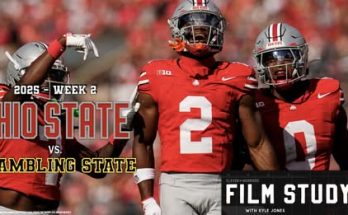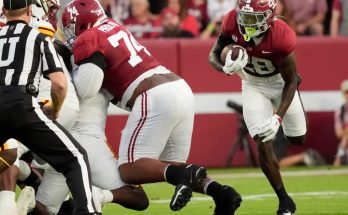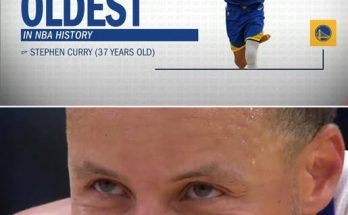Breaking news shook the college football recruiting landscape today as the nation’s No. 1 overall prospect, five-star phenom David Sanders Jr., flipped his longstanding commitment and announced that he will be joining the Ohio State Buckeyes, snubbing both BYU and Georgia in a stunning turn of events. This bold move instantly sent shockwaves across the country, not only due to Sanders’ elite status but also because of the broader implications for power programs vying for national dominance. The ripple effect of this decision will be felt from coast to coast, from coaching offices to recruiting boards, and through locker rooms filled with hopeful players and staff who had built entire schemes around the belief they had already secured the most coveted player in the country.
David Sanders Jr., a towering offensive tackle from Charlotte, North Carolina, had long been considered a lock for the Georgia Bulldogs. For months, Kirby Smart and his staff poured energy, time, and strategic resources into keeping Sanders locked into his verbal commitment. Georgia was selling a dynasty-in-the-making. Coming off back-to-back CFP National Championship appearances and a reputation for developing NFL-ready linemen, Georgia was the logical choice. And yet, this latest twist proves once again that in modern college football, nothing is guaranteed—especially when it comes to NIL deals, shifting coaching dynamics, and the growing magnetism of programs like Ohio State that know how to seal the deal when it matters most.
BYU, while never the front-runner in the conventional sense, had also made a surprisingly strong push for Sanders. Head coach Kalani Sitake’s program has leaned heavily into recruiting elite players from across the country, and Sanders had expressed genuine admiration for the team’s culture and emphasis on personal development. BYU fans had reason to believe they could be the dark horse winner in this recruitment. With the Cougars now competing in the Big 12, the lure of Power Five football, a passionate fan base, and an increasingly national recruiting presence had turned BYU into a legitimate contender. Their efforts nearly paid off—but “nearly” isn’t good enough when a talent of Sanders’ caliber is at stake.
Yet it is Ohio State—under the meticulous guidance of head coach Ryan Day and offensive line coach Justin Frye—that ultimately pulled off the coup. What looked like a longshot just weeks ago now represents one of the most impactful recruiting flips in recent college football history. According to sources close to the Buckeye program, Ohio State never fully let go of their pursuit of Sanders, even when he verbally committed elsewhere. They stayed in contact, built relationships with his inner circle, emphasized their track record of sending offensive linemen to the NFL, and painted a vision of Columbus where Sanders wouldn’t just play football—he would be the face of the future.
The momentum had been building quietly. There were whispers of a visit to Columbus earlier this month that went underreported. Recruits talk, and Ohio State’s recruiting class—already top-tier—had become unusually active on social media in the past 48 hours, suggesting a major domino was about to fall. It turns out that domino was the No. 1 player in the country.
Sanders’ decision comes at a pivotal time for Ohio State. The Buckeyes have faced mounting pressure from fans and boosters to reclaim their spot at the apex of college football. While the team has consistently fielded elite talent, they’ve recently struggled to clear the hurdle that is Michigan in the regular season and finish off strong in the College Football Playoff. Bringing in the top prospect in America—especially one who plays in the trenches where games are so often won and lost—signals a clear message: Ohio State isn’t just looking to compete. They’re looking to dominate.
From a pure football standpoint, Sanders is a generational talent. At 6-foot-7 and over 300 pounds, he possesses elite athleticism, lateral quickness, and a football IQ rarely seen at the high school level. He’s been praised for his hand placement, footwork, and his ability to mirror edge rushers like a seasoned NFL veteran. Many scouts have called him a “plug-and-play” left tackle, someone who could step into a starting role at most Power Five programs as a freshman. That’s exactly the kind of anchor Ohio State needs to protect its future quarterbacks and power its run game for years to come.
Equally important is the symbolic weight of Sanders’ flip. Recruiting is not just about acquiring talent—it’s about winning the perception battle. And today, Ohio State has outmaneuvered two very different yet formidable foes. Georgia, the reigning king of the SEC, now has to recalibrate. They lost a player they thought was a sure thing. Meanwhile, BYU, while perhaps not devastated in the same way, loses a moment that could’ve signified their arrival on the national stage. For them, this was more than a football commitment—it was a cultural milestone that now slips through their fingers.
In Sanders’ statement released on social media, he thanked both Georgia and BYU for believing in him and shaping his recruitment process, but he made it clear that Ohio State felt like “home.” He spoke about the bond he felt with Coach Day and Coach Frye, the excitement of joining a historic program that has produced some of the game’s greatest linemen, and his belief that Columbus was the place where he could grow both as a player and a man. The Buckeye fanbase erupted online. Message boards lit up, Buckeye Twitter trended for hours, and recruiting insiders confirmed that this decision dramatically alters Ohio State’s class, now positioning it as the potential No. 1 recruiting class for 2025.
For Georgia, there’s no sugarcoating the sting. They’ll pivot quickly—top programs always do—but this one will hurt. Sanders was not only expected to be a future All-American but a leader in a class that many considered the most important of Kirby Smart’s recent tenure. Missing out on an anchor tackle can create ripple effects, especially when offensive line continuity is such a cornerstone of Georgia’s game plan.
As for BYU, the silver lining is that they were in the room. That matters. The Cougars’ aggressive recruiting strategy under Sitake is clearly starting to bear fruit, even if they didn’t land the biggest prize. Their continued presence in the recruitment of five-star players bodes well for the program’s trajectory. Still, there’s a lesson here: closing the deal on elite prospects will require not just presence but proof—proof of winning big games, developing NFL players, and offering NIL packages that compete with the big boys.
In today’s college football world, the decision-making process for recruits is more complex than ever. It’s not just about tradition or playing time anymore. It’s about development, branding, trust, and increasingly, financial opportunity through name, image, and likeness deals. Though unconfirmed, sources suggest that Sanders was presented with a significant NIL opportunity at Ohio State—one that, when combined with their developmental track record and media exposure, became too good to pass up.
There will be ripple effects to this move that stretch beyond these three schools. Other offensive line prospects will reevaluate their destinations. Coaching staffs across the country will shift resources. Commitments may wobble, and confidence may shake. This is how seismic recruiting decisions work—they don’t just shift rosters; they shift narratives.
Ohio State has now planted its flag firmly in enemy territory. They went into SEC stronghold Georgia and beat out the Bulldogs for a player they deeply coveted. They beat a rising BYU program that has refused to be intimidated by anyone. And they did it with precision, patience, and poise. For Ryan Day and his staff, it is a resounding affirmation of their strategy. For the fans in Columbus, it’s a cause for celebration. For the rest of the country, it’s a reminder that when it comes to the arms race that is college football recruiting, Ohio State remains very much a superpower.
As for David Sanders Jr., the spotlight will follow him now more intensely than ever. With fame comes pressure, with expectations come scrutiny, and with the title of “No. 1 prospect in America” comes a legacy to uphold. But from every indication, Sanders isn’t just ready—he’s eager. The path ahead is bright, the Buckeyes are surging, and college football just got a lot more interesting.



